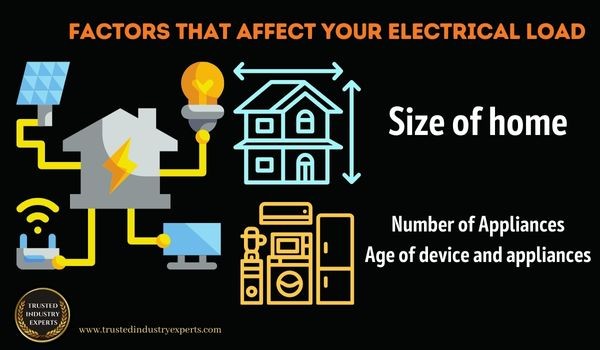
Understanding Electrical Loads: A Comprehensive Guide
As homeowners and businesses alike look for ways to reduce their energy costs and minimize their carbon footprint, more and more people are turning to solar energy. However, before you can make the switch to solar, it’s important to understand what your electrical load is and how it affects your energy usage. In this guide, we’ll take a deep dive into the topic of electrical loads and what you need to know to make an informed decision about your energy needs.
Our home’s electrical load is the total sum of all the wattage ratings of the appliances that consume electrical energy. This includes everything from our lights and televisions, to our washing machines and refrigerators. Each of these appliances has a rating in watts, which is determined by the manufacturer based on how much power it needs to operate.
The wattage ratings of all the appliances in our home that consumes electrical energy are essential to consider since those, together with other electrical elements, will determine the load of our home’s circuits. For example, some electronics and appliances contain capacitive loads, which are electrical components that draw power even when they’re not in use and thus increase the power output.
What is Electrical Load?
Electrical load refers to the amount of electricity that a device or system requires to operate. In the context of solar energy, your electrical load refers to the amount of electricity you use in your home or business. This load is measured in kilowatt-hours (kWh) and can be determined by looking at your energy usage over a certain period of time.
Types of Electrical Loads
There are two main types of electrical loads: continuous and non-continuous.
Continuous loads
Continuous loads are those that operate for extended periods of time, such as refrigerators and air conditioners.
Inductive loads, such as electric motors, transformers, and fluorescent bulbs, draw current from the electrical grid in order to operate. Capacitive loads, on the other hand, are devices that store electricity when not in use and then release it slowly into the system.
When determining the total electrical load, it is important to consider both the power requirements of each device and the amount of electrical power available from the circuit breaker. For instance, if a household has several large appliances that require a large amount of power, such as a clothes washer and dryer, then it may be necessary to install a tandem breaker.
Non-continuous loads
Non-continuous loads are those that operate intermittently, such as televisions and computers.
The entire electrical service of a home or business is determined by the electric load that it requires. The electrical load must be taken into consideration when determining the size of a solar panel system needed to generate electricity for the building. In order to reduce costs, it is important to have an accurate calculation of the electric load in order to get the most accurate input and output of solar panels.
The electrical capacity of a home or business is determined by the total capacity of each individual appliance or device that draws power from the breaker box. This total electrical capacity can be calculated by adding up the watts ratings of each device and knowing the wattage rating of your breaker box. Knowing the total electrical capacity of your home or business can help you determine the cost of each appliances inside your home.
Electrical Load calculation
To determine your electrical load, you’ll need to gather information about the appliances and devices you use in your home or business. You can do this by looking at the specifications for each device and determining the amount of energy it uses per hour. Once you have this information, you can add up the total energy usage for each device to get an estimate of your electrical load.
Once you have the total electrical load of your home or business, it is important to consider the suggested amperage rating for each device as well as the total amperage rating of your current electrical service. If the total amperage your home or business requires surpasses the maximum capacity of your current electrical service, then it is necessary to monitor the electric appliances.
In addition to the total electrical load, it is also important to consider the number of plug in outlet circuits and individual circuits available. Each circuit should be calculated separately to determine the total wattage of the entire system. This will help ensure that your electrical service is adequate for all of your appliances and devices. It can also be helpful to install single breaker.
Factors That Affect Your Electrical Load

There are several factors that can impact your electrical load, including:
The size of your home or business
The number of appliances and devices you use
The age of your appliances and devices
The efficiency of your appliances and devices
How Electrical Load Impacts Solar Energy
Your electrical load plays a crucial role in determining the size and cost of your solar energy system. If you have a high electrical load, you’ll need a larger and more expensive system to meet your energy needs. On the other hand, if you have a low electrical load, you can opt for a smaller and less expensive system.
Electrical load
Understanding your electrical load is an important first step in making the switch to solar energy. By understanding the types of loads you have, how to calculate your electrical load, and the factors that can impact it, you can make an informed decision about your energy needs and choose the right solar energy system for your home or business.
Electrical Service
Home’s electrical system is a complex yet important component in keeping everything running smoothly. In a time where technology changes rapidly and electrical needs increase exponentially, making sure that the electrical load delivered to the residence is sufficient and sustained is more important than ever.
To ensure electrical service conforms with safety standards, sizing the electrical infrastructure components to handle a capacitive load appropriately is essential. A well-maintained electrical service will not only provide you and your family with safe power, but also peace of mind for years to come.
The fuse box is the main power supply to the home, so it’s important to make sure that it has enough capacity to handle all of the appliances and devices in your home. A sub panel may be needed if the existing service is not adequate for powering the new circuits. In some cases, an additional service line may need to be installed fuse box, power systems and light fixtures.
Electrical Appliances
In this diagram, we see that continuous loads, such as refrigerators and air conditioners, operate for extended periods of time, while non-continuous loads, such as televisions and computers, operate intermittently. Understanding the difference between these two types of loads is important for determining your electrical load and choosing the right solar energy system.
In addition to the appliances and devices discussed above, you should also consider how much electricity is used to power other electrical loads such as electric heat and hot water heaters. These are two of the biggest contributors to an electricity bill.
When calculating your total electrical load, it is important to take into account both resistive and inductive loads. Resistive loads are those that require a constant amount of power, regardless of their current usage. These include hard-wired appliances such as refrigerators and air conditioners. Inductive loads, on the other hand, require more power for individual appliances needs high amount of loads.



